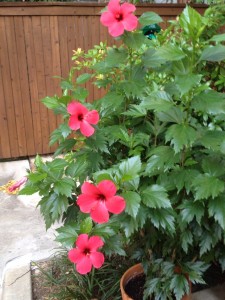Thursday trots, twists and twirls through today and toward tomorrow.
Outside the front door, we have a hibiscus plant in a pot that has survived a number of winters. I forgot one year and left it out on a cold night. Languish though it did in the garage losing most of its leaves, it popped back with the spring rains and the summer heat. As you can see below, it is looking quite nicely this hibiscus Thursday.
No one knows for sure the origins of the hibiscus. It’s Latin name, Hibiscus rosa-sinensis, is a combination of the Greek word hibiscus, meaning “mallow,” and the phrase rosa-sinensis, meaning rose of China. Most folks think it originated in South China, but that pesky Greek term represents one of the earliest plants cited in recorded literature. The Roman poet Horace, who was born in 65 BC and who may have been one of the earliest health nuts, ate olives, endives and mallows for sustenance. Perhaps he even had a bit of hibiscus tea. People still do that, and the teas are quite tasty.
Hibiscus grow wild in Singapore and are used as road dividers — it must be pretty to drive there. Two white hibiscus are believed to be native to Hawaii — maybe I’ll see them later this summer. A scarlet hibiscus is native to the water-logged swamps of southern Florida — from the pictures, it’s a beauty. The flowers and other parts of the hibiscus plant can be used for food, medicine, eye liner, hair dye and shoe polish, among an extensive litany of other applied uses.
To conclude this short introduction to hopefully a new friend, the hibiscus is a versatile and attractive plant of ancient and mixed origins, comfortable behind the ear (to indicate availability for marriage) or parked in a pot on the front step (just to say “Hello” and brighten the day).
A Happy Hibiscus Thursday to You,
Grandpa Jim
PS: As you may have noticed, the singular and plural forms of hibiscus are the same, hibiscus.

